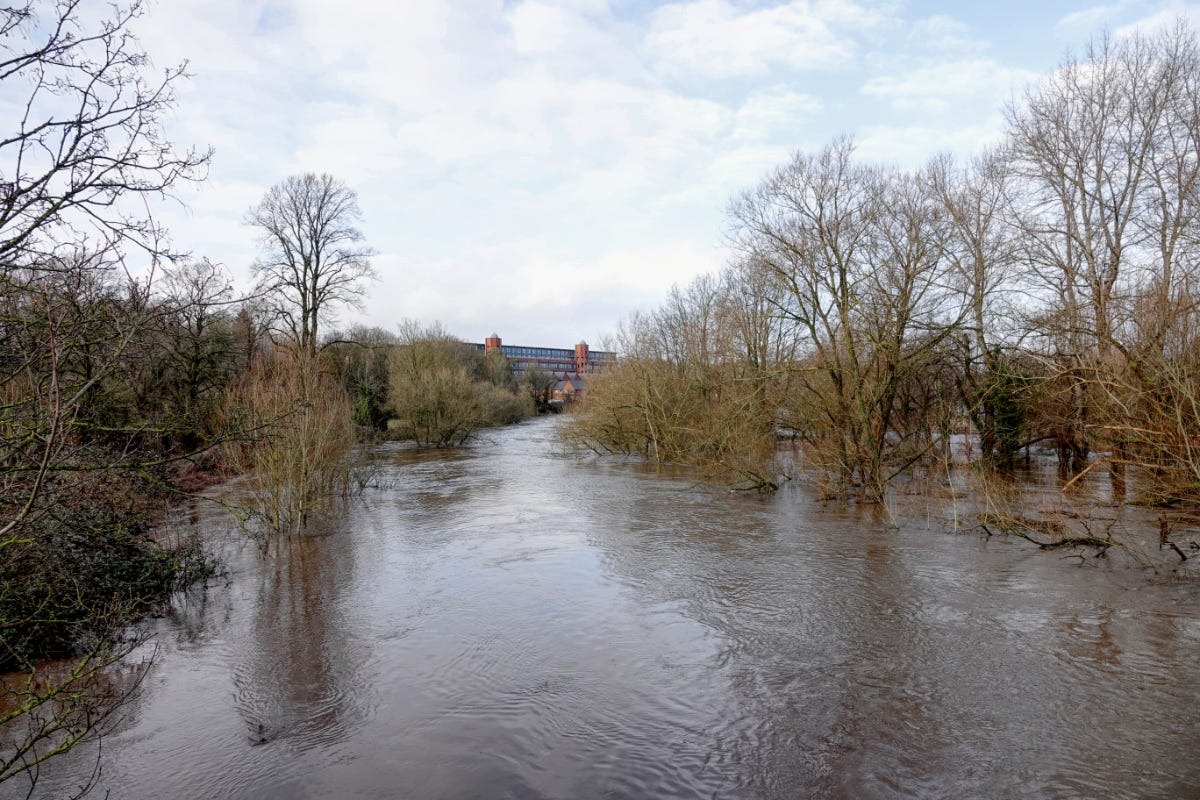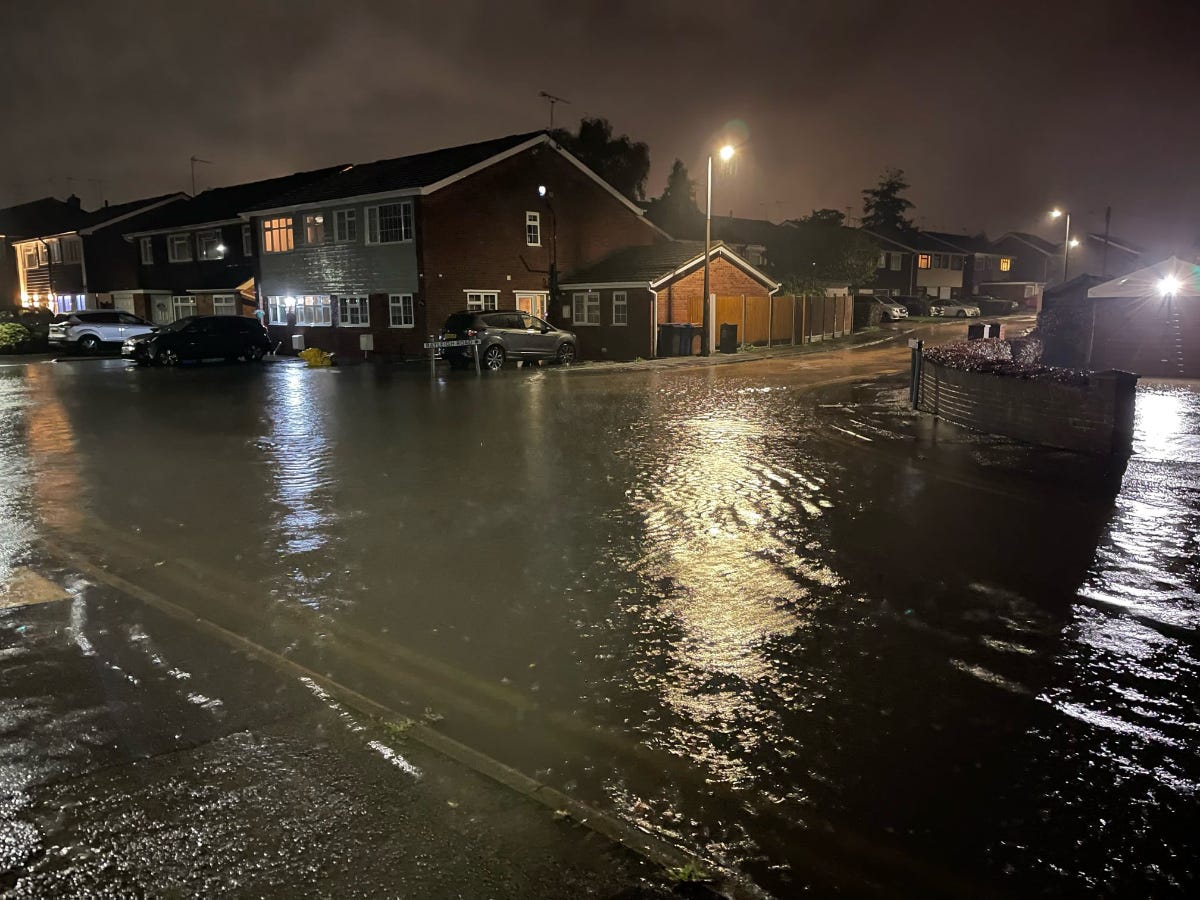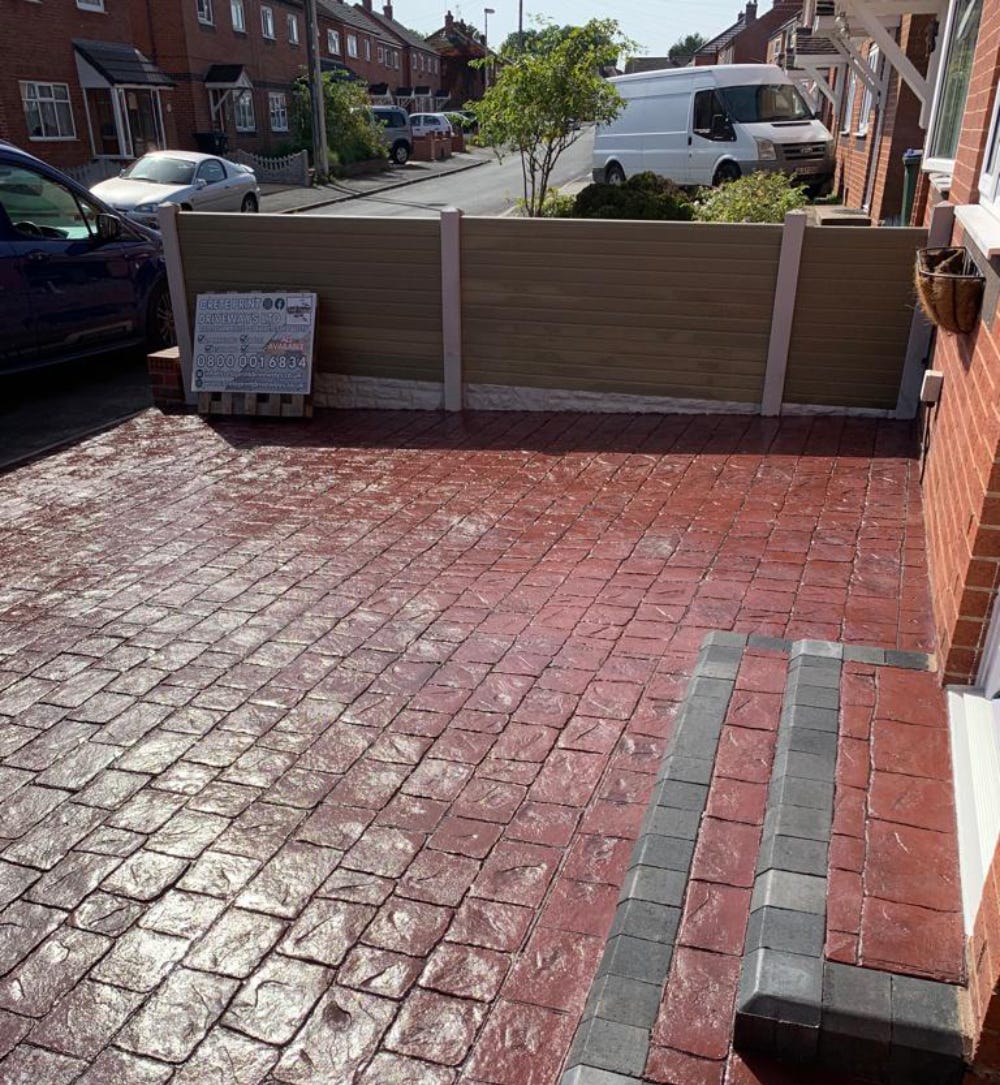A swollen River Avon that has burst its banks as it flows past Keynsham. This photograph was taken on 12.01.23.
A swollen River Chew surging its way through Keynsham Memorial Park. This photograph was taken on 14.01.23.
Preamble
It was a wet September here in the West Country of England: UK hit by record September rainfall as warning in place for more wet weather - Jessica Rawnsley, Sam Rucker | iNews | 1.10.24. Although we have a few days respite from the rain coming up, more is forecast to fall as we go through October. Already, the fields are getting waterlogged. I was on a community litter pick last Saturday (28.9) and one area that I have cleared in the past is already under a couple of feet of water, so I couldn't clear it. If we get the same level of rainfall that we've had in the previous two winters, flooding is inevitable. If we get more rain than we've had in the previous two winters, that flooding will be more serious because the ground will already be waterlogged, and there will be nowhere else for the water from the rainfall to go other than already swollen, brooks, streams and rivers.
Faced with this prospect, my thoughts are turning towards what can, and should be getting done in terms of putting in flood mitigation measures. I want to offer my apologies now to any of my readers from outside the United Kingdom as what follows is mostly specific to the situations I've experienced where I used to live in Essex, and where I now live in Keynsham, between the cities of Bath and Bristol. I also recognise that the flooding situations I've witnessed and experienced are tame to what people in other parts of the world have had to endure, not least, the flooding that has devastated communities in the US state of North Carolina, reportedly in the wake of Hurricane Helene: Helene updates: Over 120 dead across Southeast; North Carolina ravaged by storm - NBC News | 1.10.24. Suffice to say, the more that's coming out about this disaster, the more questions are being raised.
The climate and weather patterns are changing, that much is obvious from observation and lived experience. What I don't want to do with this piece is get tangled up in a discussion about why the climate is changing, whether that's down to rising CO2 levels as some would argue, or as others have claimed, intentional manipulation of the weather, or indeed, other factors. This may be something to be addressed in a future piece, but not now. The title of this piece is 'A few thoughts on flood mitigation...' It's the measures, or the lack of them, to cope with the impact of high rainfall and the subsequent flooding that I want to deal with in this piece. This is because from my experience, both here in Keynsham, and particularly when I was living back in Essex, there's a lot of basic things that could and should be done but aren't getting done.
The problem as we've experienced it
Flooding in the park opposite where we used to live in Stanford-le-Hope.
Before we moved down to Keynsham just over two years ago, we lived in Stanford-le-Hope which is in the eastern end of Thurrock, on the Essex shore of the Thames estuary. We lived in a low lying part of the town which, a few years after we had moved in, we found out the hard way was prone to flooding. There were a range of reasons why the road we used to live in, the park opposite, and the road on the other side of the park flooded on a regular basis. One factor was Anglian Water neglecting the nearby pumping station which had a habit of failing at crucial times during heavy rainfall. Another was poor maintenance of street drains which were often blocked, leading to surface water flooding. Then there were more fundamental hydrological changes resulting from a couple of new housing developments adjacent to the stream that flowed through the town, plus the widening of the nearby A13 main road. Last but by no means least, there was a new housing development on a slope just to the west of the town, which because of the amount of hardstanding around the homes, led to the excess water from heavy rainfall, running down into the neighbourhood we used to live in! With such a range of factors contributing to the problem, it was the perfect excuse for Anglian Water, Thurrock Council, the Environment Agency and other bodies involved to constantly pass the buck rather than address the root causes of the flooding.
Eventually, a report of sorts was compiled but, while if offered a few interesting solutions, it didn't take the holistic overview of the causes of the flooding in January 2021 that we were hoping for: Not the holistic look at the January floods in Thurrock that we were hoping for - The Stirrer | 13.7.21. There was one interesting idea suggested, which was investigating how applying natural management techniques close to the headwaters of the streams that ran down into Stanford-le-Hope. This was also to apply to the streams that ran down to the Mar Dyke which empties into the Thames in the west of Thurrock. The Mar Dyke also experienced serious flooding, all the way up to Bulphan, a small village that's eight miles inland from the Thames.
Flooding in the road outside the house (just off to the right of this photograph) when we used to live in Stanford-le-Hope.
The last incident of flooding we experienced before moving down to Keynsham was in the October 0f 2021: Again FFS! 21.10.21. Luckily, we didn't get any floodwater in the house we were living in at the time. However, it was a close shave and is only through hours of heavy broom pushing to get the water away from our house, that we kept it dry. This incident nearly put the mockers on us moving down to Keynsham as we thought we'd have trouble selling our home. This is what we had to say after this incident:
As we’ve written before, there’s no single answer as to why we keep getting flooded. There are a whole range of contributory factors from the intensity of the rain, through over-development and drainage systems not being upgraded to cope, and last but but no means least, piss poor maintenance of the road drains. What also needs to be taken into consideration is what happens at the headwaters of the streams that flow into and through Thurrock.
A holistic overview that considers all the contributory factors is definitely needed. The thing about such an overview is that it will inevitably raise some difficult questions about planning policy, particularly why building developments on low lying, flood prone sites, are still allowed to go ahead. We’ll be doing what we can to ensure that this time round, we get some proper answers…
When we moved down to Keynsham, obviously one of our criteria was finding a location that wasn't going to flood. Which is why we live on top of a hill, looking out over the Avon valley and also, the low lying sports pitches at Crown Fields, both of which have flooded two winters on the trot and were waterlogged again just a few days ago. Our first experience of seeing flooding where we now live was in the winter of 2022/23. This was on a bigger and more intense scale to anything we'd experienced when we were living back in Essex. It was from the Avon and also, the River Chew which flows in a steep sided valley right through the middle of Keynsham. During the first winter we were down in Keynsham, I distinctly remember asking one of the bar staff in our riverside local pub whether this flooding was a regular occurrence each year. He confidently said that this scale of flooding only happened once every decade. Come the winter of 2023/24, the flooding returned, and if anything, it was worse that the winter before!
Obviously, the factors that caused the flooding where we lived back in Essex are different from those causing the flooding where we are now. We're talking about a very different topography and also, different farming practices as well. Where we were in Essex was predominantly arable. Where we are now in Keynsham is predominantly pastoral. The section of the Avon floodplain that we're familiar with is between Keynsham and Bath. It's mainly meadow and pasture and to a certain extent, flooding is factored in when it comes to how they're managed.
There's nowhere for the water to go other than into the road.
Having said this, there are some common factors, urban run off being one of them. I'm old enough to remember the 1960s and 70s when front gardens had shrubs, flowers and a bit of grass in then. When it rained, the vegetation and soil soaked up a fair bit of the water. These days, in a society that's structured in such a way as to make car ownership a necessity, it's rare to see a front garden given over to shrubs, flowers and grass. Hard paved surfaces for parking, all too often impermeable, are all too common. So, when heavy rain comes, there's nothing in a front garden to soak it up: Gardens being uprooted in favour of driveways and artificial grass, new research reveals - The Flood Hub. The consequence is that the amount of water directly flowing into drainage systems increases, along with the chances of them being overwhelmed. Then there's the common bugbear of poorly maintained and frequently blocked street drains which unnecessarily add to the problem.
Developers of new build housing developments all too often have a lot to answer for. That's not just the excess of hardstanding to accommodate two, three or more cars per household. It's putting in land drainage systems that are simply not fit for purpose. The new estate where my daughter and son-in-law live is a classic example of this. There's an attenuation pond on their development which, despite all of the intense rain they've experienced, has never filled up with water. On the other hand, after heavy rain, their garden turned into a morass. It was only after some back breaking labour fixing the land drainage in the garden and relaying the lawn that the problem has been solved. They are far from the only residents to have experienced issues with this.
Solutions?
Clearing blocked street drains like this one would be a useful start.
So, what can be done to mitigate the impacts of heavy rainfall and the consequent flooding? They range from the very simple and basic through to the complex. Unblocking street drains is a start, albeit blocked drains are just one of a number of factors leading to flooding. However, it would be nice if local authorities could actually resume properly undertaking the basic functions they're supposed to do, without any dramas, keeping street drains clear being one of them. Failing that, residents could always get together to undertake that task, log the time undertaken and what is a fair rate of pay for the work involved, note the cost of any equipment purchased, and then deduct that from their council tax payment until the local authorities decide they need to pull their finger out.
As for the ubiquity of hardstanding, impermeable surfaces serving as parking spaces where people used to have front gardens, there are no easy or inexpensive answers. A society where people didn't have to rely on their cars so much to get around would be welcome, as at least some of the hardstanding parking would be redundant and could be ripped up, with a more natural, water absorbent surface put in to replace it. Failing this, permeable surfaces are available for use in parking areas however, I recognise that replacing a hardstanding, impermeable surface with one that will absorb more water is not going to be a cheap option.
There's a lot housing developers could do to build estates that won't flood or send excess surface water into neighbouring areas. As already mentioned, there's also a lot they could do better when it comes to putting in land drainage systems that actually work without adding to the flood risk in neighbouring areas. There's plenty out there in the way of advice and guidelines: Planning & Development - The Flood Hub. With the UK government keen to launch a new wave of homebuilding, some pressure on developers to make their developments and neighbouring areas genuinely flood proof really wouldn't come amiss. Obviously this takes in not building any more developments on floodplains!
A rain garden designed to soak up excess rainfall.
One simple thing that can be done in existing urban areas where there's the room and also, planned into new developments is this: Rain gardens - Gloucestershire Wildlife Trust and this: How to make a rain garden - WWT. Again, installing rain gardens where appropriate would be only one of a range of measures that's needed but, they do make a difference in urban areas.
Better land management in rural areas alongside rivers and in particular, around the headwaters of our rivers, would make a significant difference. This can only work by taking a holistic look at what happens in a river basin. This ranges from an evolution of farming practices towards those that reduce downstream flood risk (and pollution) through to encouraging re-wilding aimed at holding back excess water rather than allowing it to flow into the river, overwhelming its capacity. This is one such imaginative and visionary proposal to start out on the pathway towards achieving this: Regenerate River Avon - We Are Avon. There's also this: Create a community woodland on the River Avon. What really stood out in this proposal for a community woodland were these points:
Wet Woodland - Closer to the river the conditions are right to create some magical wet woodlands, which are particularly rare. "Wild, transient, boggy and rare. Wet woodlands are now some of our least common wooded habitats. Trees like alder, willows and birch dominate on wet soils, while sedges, ferns and mosses flourish beneath." -- Woodland Trust
Wildlife Ponds & Wetlands - This site will be perfect for "rewetting", which means we can landscape areas adjacent to the Avon to create permanent ponds, seasonal scrapes, and other ephemeral water bodies to help wildlife and prevent flooding downstream.
A brief conclusion
This piece is not intended to offer a comprehensive range of solutions to the problems caused by flooding here in the UK. The aim is to try to contribute to an informed discussion about what can be done in the here and now regarding flood mitigation. It's also aimed at trying to contribute towards a discussion about longer term measures that would involve some significant changes in thinking and outlook. It's a case of learning to work with and adapt to nature, rather than fighting it, trying to dominate it, and then paying the price for it. It's also a case of learning how to adopt genuinely holistic, joined up thinking and then applying it. In a lot of cases, it's about applying some basic common sense. Whether those who presume to rule over us are invested in any way in genuine attempts at flood mitigation is debatable. There are things those of us at the grassroots can be doing though. Any creative but workable ideas are welcome:)












It's so important to address all these reasons why we are experiencing flooding at the moment. The drains around where I live have quite obviously not been cleared by South Glos in years. New build terraced houses with teensy weensy gardens and lots of hard parking space.
Thanks for the rain garden links - really interesting.